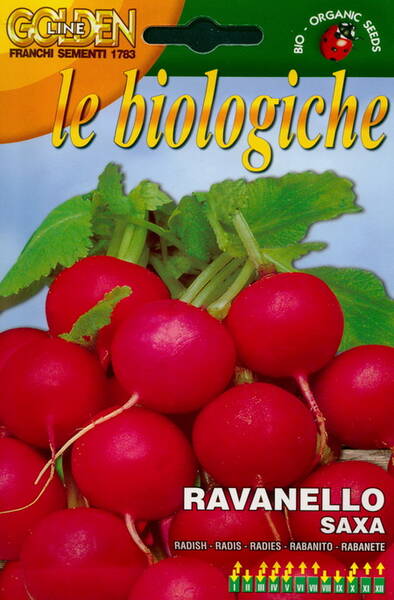Ex Tax: 2.04€
Very easily grown and quickly growing vegetable. Early variety, grows in 22–25 days. Root vegetables are red, juicy and delicious.
For early harvest grown in greenhouses, for spring harvest sown outdoors. To have radishes in late summer, seed them in late July or the beginning of August.
Grows well in fertile soils. Watering is necessary when the soil is dry.
* Radishes are short-day plants. It grows better if you transfer it to a short day, that is, from 19 pm to 7-8 am, and cover it with an opaque black film or a wooden box. With this method of cultivation and good watering, radishes can grow up to 10 cm in diameter without losing their taste. This should be taken into account first of all by the owners of greenhouses.
One of the biggest frustrations of a gardener when growing radishes is the flowering of plants. Try the old peasant way. If the radish is preparing to release an arrow, press the root crop with two fingers and press it into the soil.
If the light day is too long, the radish can be shaded in this way. They make a removable frame, covered with an opaque material, for example, roofing paper. The frame is placed at 8 pm and removed at 7 am the next day. Thus, radish plants will have a normal 13-hour light day for their development.
And stemming radishes can also reduce the constant wetness of soil in radish beds. Drying of the soil should not be allowed. It is recommended to water radishes in the evenings every 2-3 days, and in drought - daily, morning and evening.
In the first 10 days of radish development, the ground during irrigation should be soaked to a depth of 8 cm, with the beginning of root formation - no less than 15 cm.
Radishes, spinach and daikon give a good harvest only with a short day regime, so they can be sown again at the end of summer: in early August in more northern regions, and in the middle lane - until August 15.
Cabbage flies and fleas cause great damage to the radish crop. In order to get rid of them, it is impossible to use chemical preparations, since radish is an early and juicy product. It is better to scatter tobacco between the rows after watering before loosening. If there is no tobacco, then black or red pepper will do (a teaspoon per square meter).
When growing daikon, it is better not to introduce fresh manure into the soil, as it causes the branching of root crops. Under this culture, rotted manure is embedded in the soil in the fall.
Varieties of radish are easily cross-pollinated with each other, with wild and cultivated radishes. Therefore, in order to obtain radish seeds of the variety you like in your garden, it is necessary to isolate seed plants with gauze or make a frame from a fine mesh for several plants. In this case, they pollinate by shaking flowering plants, and flies can be bred under the frame by placing pieces of meat or fish under it.
To get a continuous radish conveyor, each subsequent sowing must begin immediately after the appearance of the first leaves in the previous plantings.
Very few gardeners sow radishes in the fall, but in vain! Autumn radish is tastier than spring radish: it grows large, never produces a peduncle, does not flabby, is devoid of bitterness, sweet and juicy.
In addition, in autumn, radish seedlings almost do not damage cruciferous fleas. You can keep radishes in the garden until the onset of cold weather, removing them as needed.
Depending on the location, autumn radishes are sown throughout August and early September. These terms are also affected by the maturation time of various varieties of radish. For the autumn culture of radishes, it is more expedient to choose early-ripening varieties of radishes.
With a strong thickening or clogging of radish crops with weeds, the plants form small and ugly root crops.
Sometimes when sowing a radish, its seeds are scattered. They can be left to sprout where they are scattered, and then, in cloudy weather, carefully remove them from the soil and plant them in the right place, observing the planting rate. The same good root crops will grow from the spilled seeds, but only with a delay of several days, the main thing is not to forget about abundant watering.
Eng.: Radish. Suom.: Retiisi. Sven.: Rädisa. Bot.: Raphanus sativus L. var. sativus.











